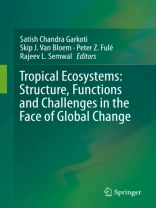The book brings together research topics having a broad focus on human and climate change impacts on the terrestrial ecosystems in the tropics in general and more specifically from the most significant and vulnerable Himalayan ecosystem. A total of 16 contributions included in the book cover a diverse range of global change themes such as the impacts of changing temperature and precipitation on soil ecosystems, forest degradation, extent and impacts of invasive species, plant responses to pollution, climate change impacts on biodiversity and tree phenology, environmental changes associated with land use, importance of traditional knowledge in climate change adaptation, timberline ecosystems, and role of integrated landscape modeling for sustainable management of natural resources.
The book is a collective endeavour of an international multidisciplinary group of scientists focused on improving our understanding of the impacts of global change on the structure and functioning of tropical ecosystems and addressing the challenges of their future sustainable management. We hope that the book will help researchers working in the areas of ecology and environmental science to update their knowledge. We also expect that natural resource managers and policy planners will find explanations for some of their observations and hypotheses on multiple global change factors impacting tropical ecosystems and especially Himalayan ecosystems.
Содержание
Introduction.- Influence of Changing Patterns of Precipitation and Temperature on Tropical Soil Ecosystem.- Nature and Extent of Forest Degradation in Central Himalayas.- Management of invasive alien plants in Nepal: current practices and future prospects.- Invasive species and their impact on tropical forests of Central India- a review.- Aboveground tree carbon stocks along a disturbance gradient in wet tropical forests of south Assam, India.- Responses of tropical and sub-tropical plants to air pollution.- Shorea robusta forest resources of Mainpat/Phendeling Tibetan Refugee Camp, Chhattisgarh, India.- Ecology of Treeline Vegetation in Western Himalaya: Anthropogenic and Climatic Influences.- Ideas and Approaches for Studying Treelines in the Himalayas: Expanding the Concept from a Landmark to Community and Ecosystem Levels.- Community Response and Adaptation to Climate Change in Central Himalaya, Uttarakhand, India.- Environmental Changes and Challenges of Tarai and Siwalik of Nepal.- Ecological value and change sensitivity based approach for defining integrity of forests in west Himalaya, India.- Himalayan biodiversity in the face of climate change.- Phenological Pattern and Community Structure of Dipterocarpaceae in Bukit Barisan Selatan National Park, Lampung.- Integrated landscape modelling in India: Evaluating the scope for micro-level spatial analysis over temporal scale.- Conclusions and way forward.
Об авторе
Dr. Satish Chandra Garkoti, is a Himalayan ecologist and specializes on Forest Ecology with emphasis on forest productivity and nutrient cycling, tree ecophysiology, phenology, biodiversity characterization, and climate change adaptation and mitigation. He is among the pioneers to contribute to structure and functioning of high elevation forest ecosystems leading to tree-line in the Himalayas. Plant diversity characterization in tropical forests of North Eastern India and estimation of ecosystem services in Himalayan forest ecosystems are other areas where he has made substantial contributions. Dr. Garkoti has published a large number of research papers in international and national Journals of repute. Dr. Garkoti is Rector in Jawaharlal Nehru University and Professor in School of Environmental Sciences. Currently he is leading a Task Force on creating a coherent database on traditional knowledge systems in the Indian Himalayan region which is an integral part of National Mission for Sustaining the Himalayan Ecosystem under India’s National Action Plan on Climate Change.
Dr. Skip J. Van Bloem is a tropical forest ecologist. His research has centered on how large infrequent disturbances such as hurricanes generate physiological responses in trees and how those responses shape long-term patterns in tree population and community dynamics. His work also evaluates long term responses to anthropogenic disturbances related to land use change and wildfire. Most of his research has been in seasonally dry systems in Puerto Rico and elsewhere in the Caribbean. He is currently the director of the Belle W. Baruch Institute of Coastal Ecology and Forest Science and a professor in the Forestry and Environmental Conservation department at Clemson University and was previously the president of the International Society of Tropical Ecology. He earned his Ph.D. from Michigan State University, M.S. from the Ohio State University, and B.A. from Western Michigan University.
Dr. Peter Z. Fulé studies the interactions between forests, fires, and climate. He uses historical ecology techniques, including dendrochronology (tree-ring analysis), to study these interactions during past centuries. He uses experimental studies in forest restoration to test methods of restoring resilient forest ecosystems and applies simulation models of vegetation change under alternative climate change scenarios and management activities to forecast future forest development and test strategies for forest conservation. Dr. Fulé does research in the US, Latin America, Asia, Indonesia, and the Mediterranean region. Currently Dr. Fulé is the Charles O. and Mary Minor Professor in the School of Forestry, Northern Arizona University.
Dr. Rajeev L. Semwal holds Ph.D. in Botany and is an ecologist by training. As an ecologist, he has been making constant efforts to contribute towards developing science based institutional support systems for conservation of forests and agroecosystems in the Himalayan region. During his long research and professional career spanning over 25 years, he got opportunity to work with WWF-India, LEAD-India and subsequently as the first coordinatorof the Mountain Division at Ministry of Environment, Forests and Climate Change, Govt. of India. Presently he is working as a scientist from School of Environmental Sciences, Jawaharlal Nehru University, India for a Task Force under National Mission for Sustaining the Himalayan Ecosystem. Dr. Semwal has more than 30 research papers, many book chapters and scientific reports to his credit. His research findings are widely cited by ecologists, foresters and professionals working in the area of sustainable development in mountains across the globe.












